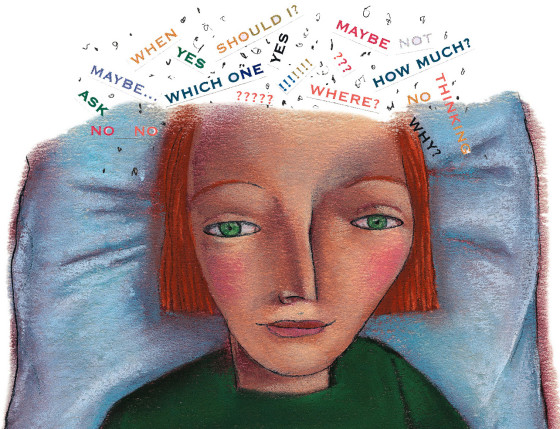Learning to Honor Self-Doubt and Move through It
Self-doubt can be such a nasty monster. Although I aspire to look at our most ineffective habits as survival resources that, at some point in our lives (often when we're young), helped us to keep going, self-doubt is one of those bugaboos that seems to bring nothing we want and everything we don't, including paralysis, self-loathing, and a whole lot of angst. 
I observe client after client live out a sliver of their lives on account of self-doubt. When I reflect on the role self-doubt has played in my own life, I see many moments of living in a painful story that prevented me both from engaging in the present moment and realizing possible dreams. But here is the thing: self-doubt in and of itself is not bad. Initially, at least, self-doubt serves as an indicator of sorts. Perhaps we are about to dive headlong into a new endeavor that warrants more caution and humility. Self-doubt might be the force that causes us to pause and move forward more wisely and skillfully. It also can spur us to consider perspectives other than our own and so engage in action with a wider, more informed lens. As Michelle McQuaid instructs, "nature has wired your brain with these uncomfortable feelings for the practical purpose of guiding your behavior."
Self-doubt becomes an issue when we identify with it--when we view it as a fixed aspect of our identity and say things like, "I can't handle this unfamiliar challenge so I might as well not even try." At that point, our attention goes largely toward feeding the self-doubt with negative beliefs, and we lose sight of other options, such as taking one small step toward a difficult challenge or unrealized dream.
A model I have found helpful for defanging self-doubt comes from a Birthing from Within class I have been taking in preparation for the birth of my child. The course's philosophy is rooted in four pillars: self-doubt, determination, faith, and love. Self-doubt is an integral part of the birthing process as it helps us to unearth the fears we have been carrying around about childbirth, often unconsciously. Having unearthed our deepest fears, we can work with them and use the other three pillars to see us through labor, delivery, and beyond. Thus we honor self-doubt as part of the birth experience and life more generally.
One of the art projects we did in the course brought these abstract ideas to life for me. Our facilitator asked us to identify one of our greatest fears and create a picture of it. Mine involved self-doubt taking over during labor. I envisioned collapsing into myself and not being able to access internal or external resources from this tight, closed space. With self-doubt at its peak, I would be forced to quit my home birth plan and submit to medical interventions not of my own choosing. The false core beliefs I learned long ago would come flooding in, particularly "You're a failure."
But picturing the fear was just the first part of the project. The facilitator then asked us to envision working with this fear and transforming it. I immediately thought of the body-based trauma training I completed and re-membered (pun intended) that I could shift my body even if my mind was screaming messages of self-doubt at me. More specifically, I could reengage my core and align my body in such a way that I was upright, with my shoulders back, and thus better able to breathe, push, and see and hear the support of the midwife and my partner. My body could serve as a guide and through its wisdom calm my thoughts and emotions. I returned to the space of saying to myself, and actually believing, "You can do this."
Later in that class session, we learned a pain coping strategy that struck me as another useful way to pull out of self-doubt's quicksand. Called ovarian breathing, this strategy comes from the Chinese ancient practice of Microcosmic Orbit. Essentially, you imagine pulling your inward breath up from the base of your spine to the top of your head and then imagine your exhaled breath moving from the top of your head down the front of your body. While exhaling, you send life-giving energy to yourself (and your baby if you're pregnant). The third step of ovarian breathing is the one that most helps us to move through self-doubt and access the other pillars: imagine a special bowl or container right above the pubic bone that captures the life-giving energy from your out-breath. Then use this collected energy to begin the next inhalation process and continue this cycle of breath. The take-away message for me in this practice is that we already have everything we need within us to keep going. I encourage you to try this practice, which is especially helpful when we feel exhausted and discouraged and does not require ovaries!
My baby's birth story is not yet written, but I can tell you that shifting my approach to self-doubt and experimenting with practices that remind me it is only a slice of my experience have allowed me to respect self-doubt and rest in determination, faith, and love. As Pema Chodron wrote, difficult emotions
are actually very clear moments that teach us where it is that we're holding back. They teach us to perk up and lean in when we feel we'd rather collapse and back away. They're like messengers that show us, with terrifying clarity, exactly where we're stuck. This very moment is the perfect teacher, and, lucky for us, it's with us wherever we are.